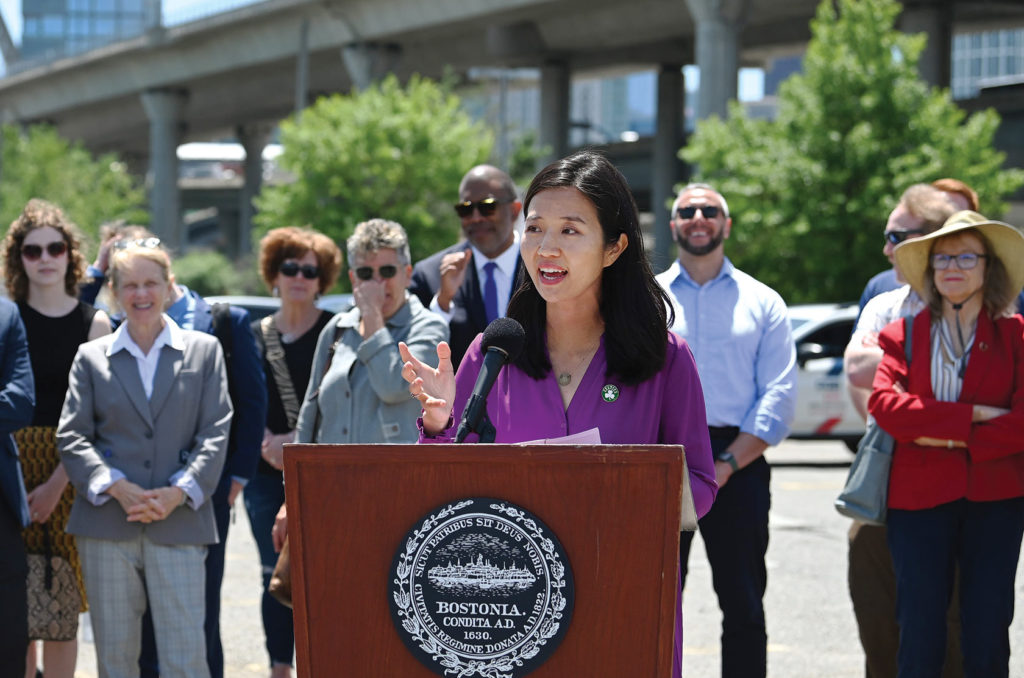
When Mayor Michelle Wu convenes her cabinet for its biweekly meeting, the faces in the room look much like those on the city’s streets: a mixture of whites, Blacks, Latinos and Asians that makes up Boston’s majority-people-of-color population.
Of the 34 department heads and senior advisors who make up the cabinet, 13 are Black, 13 are white, six are Latino and two are Asian American, making Wu’s cabinet the most diverse in the city’s history.
In an interview with the Banner, Wu said putting together a cabinet reflective of Boston’s population is critical to making city government responsive to the communities that make up the city.
“The work that we do and the impact that we can have depends entirely on how well city government is connected to community,” she said.
The cabinet positions were filled through hiring committees whose members were connected to the city’s communities, Wu said.
“We didn’t really set any internal specific numbers we were trying to hit for any specific diversity goals,” she said. “By forming hiring committees that themselves were reflective of community and ensuring we had processes to reach out to people — this is where we ended up.”
The diversity in Wu’s cabinet appears to cut across layers of city’s government, with people of color serving as policy advisors as well as heads of major departments including the police department, the Boston Planning and Development Agency, and Health and Human Services.
Former City Councilor Tito Jackson said it’s noteworthy that people of color in City Hall have real decision-making power.
“It is so important that we are deliberate about appointing people who have decision-making power and discretion over budgets, hiring and purchasing,” he said. “You want people who can deliver for those who are at the table, but more importantly, for those who aren’t at the table.”
For decades, Blacks, Latinos and Asians have been underrepresented in city government and concentrated in jobs at the lower end of the pay scale. The few departments where Blacks and Latinos have managerial positions have often tended to be those led by Blacks and Latinos, such as the Department of Public Health.
Wu said her administration is committed to increasing diversity and equity throughout city government.
“We’re certainly not done,” she said. “For me, city government is very powerful. We can move a lot of issues. But one of the most important ways we can make a difference is as an employer.”
According to a 2015 report produced by the administration of former Mayor Martin Walsh, Blacks, who made up 24% of the city’s population, were slightly overrepresented in the city government workforce, then holding 26% of the jobs, while Latinos, who made up nearly 20% of the city population, made up just 11% of city employees, and Asians, who were 9% of Boston’s population, made up just 4%.
Positions in Wu’s cabinet include department heads, advisors and chiefs, such as Mariama White-Hammond and José F. Massó, both of whom manage multiple departments. Among department heads in city government — not all of whom are in the cabinet — 50% are white, 29% are Black, 16% are Latino and 2% are Asian American.
Karen Chen, executive director of the Chinese Progressive Association, said the increased diversity in leadership positions in city government is necessary, as city residents are facing pressures including housing costs that are among the highest in the nation.
“It feels like the city is heading in a good direction,” she said. “There are so many challenges. We need people who can implement policies that will have a positive impact on people’s lives.”







